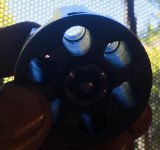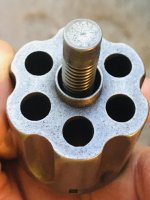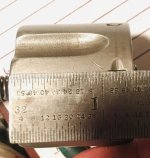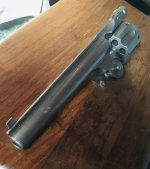I hope H Richard is not getting too bored here, but this caliber is proving to be an interesting topic for me, since I love the odd-balls. The 320 RR had the same cylinder as the early 44 Russian NM#s, so maybe any full cylinder length 32 round could be for the 320 if it is 1 7/16" long. I found five 32-44 revolvers from current and closed auctions, and they were numbered 719, 901, 4075, 22073, and 32,008. Since the first long cylinder found on a NM3 had to occur no earlier than 1886 ( around #15,000) three of the five listed had a short cylinder, the same as the 320 RR.
I would love to find a non-step cylinder in 32-44 that was factory, but after searching quite a bit, I cannot find a full length 32-44 stamped cartridge, only the short ones. Hopefully, Ralph or others who have studied these odd-ball calibers will add to the conversation. I did run across a note on two of the auctioned NM3s that said only 299 of this caliber were made, but that is still more than I would have thought.
Last bit of information to ponder is that the NM# was offered in 320 Revolving Rifle caliber!!!!!!!! So my guess is that there was never a full length 32-44 Target round made??? It makes sense that if any NM3 has a bored through cylinder it is a 320 caliber not 32-44. All 32-44 Target guns should therefore have a step in the cylinder. I would guess that a factory 320 RR NM3 would be exceedingly rare!! Iam sure, however, that I am probably wrong???
I would love to find a non-step cylinder in 32-44 that was factory, but after searching quite a bit, I cannot find a full length 32-44 stamped cartridge, only the short ones. Hopefully, Ralph or others who have studied these odd-ball calibers will add to the conversation. I did run across a note on two of the auctioned NM3s that said only 299 of this caliber were made, but that is still more than I would have thought.
Last bit of information to ponder is that the NM# was offered in 320 Revolving Rifle caliber!!!!!!!! So my guess is that there was never a full length 32-44 Target round made??? It makes sense that if any NM3 has a bored through cylinder it is a 320 caliber not 32-44. All 32-44 Target guns should therefore have a step in the cylinder. I would guess that a factory 320 RR NM3 would be exceedingly rare!! Iam sure, however, that I am probably wrong???
Last edited:










